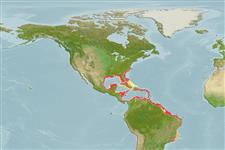Common names from other countries
Teleostei (teleosts) >
Eupercaria/misc (Various families in series Eupercaria) >
Gerreidae (Mojarras)
Etymology: Diapterus: Greek, di = two + Greek, pteron = wing, fin (Ref. 45335).
Environment: milieu / climate zone / depth range / distribution range
Ecology
Marine; brackish; demersal. Tropical; 37°N - 24°S, 98°W - 33°W
Western Atlantic: USA (Florida and North Carolina) and Greater Antilles to São Paulo, Brazil (Ref. 57756).
Length at first maturity / Size / Weight / Age
Maturity: Lm 12.0 range ? - ? cm
Max length : 42.8 cm TL male/unsexed; (Ref. 122735); common length : 20.0 cm TL male/unsexed; (Ref. 5217); max. published weight: 1.0 kg (Ref. 122735)
Inhabits shallow coastal waters, especially in mangrove-lined creeks and lagoons, but also found on vegetated sand grounds in typical marine areas. Young more widespread than adults. Feeds on bottom-dwelling invertebrates. Consumed fresh.
Life cycle and mating behavior
Maturities | Reproduction | Spawnings | Egg(s) | Fecundities | Larvae
Cervigón, F., R. Cipriani, W. Fischer, L. Garibaldi, M. Hendrickx, A.J. Lemus, R. Márquez, J.M. Poutiers, G. Robaina and B. Rodriguez, 1992. Fichas FAO de identificación de especies para los fines de la pesca. Guía de campo de las especies comerciales marinas y de aquas salobres de la costa septentrional de Sur América. FAO, Rome. 513 p. Preparado con el financiamento de la Comisión de Comunidades Europeas y de NORAD. (Ref. 5217)
IUCN Red List Status (Ref. 130435)
CITES (Ref. 128078)
Not Evaluated
Threat to humans
Harmless
Human uses
Fisheries: minor commercial
Tools
Special reports
Download XML
Internet sources
Estimates based on models
Preferred temperature (Ref.
115969): 23.8 - 28, mean 26.7 (based on 342 cells).
Phylogenetic diversity index (Ref.
82804): PD
50 = 0.5625 [Uniqueness, from 0.5 = low to 2.0 = high].
Bayesian length-weight: a=0.01122 (0.00941 - 0.01337), b=3.08 (3.03 - 3.13), in cm Total Length, based on LWR estimates for this species (Ref.
93245).
Trophic level (Ref.
69278): 2.4 ±0.9 se; based on diet studies.
Resilience (Ref.
120179): Medium, minimum population doubling time 1.4 - 4.4 years (Preliminary K or Fecundity.).
Fishing Vulnerability (Ref.
59153): Low to moderate vulnerability (33 of 100).
